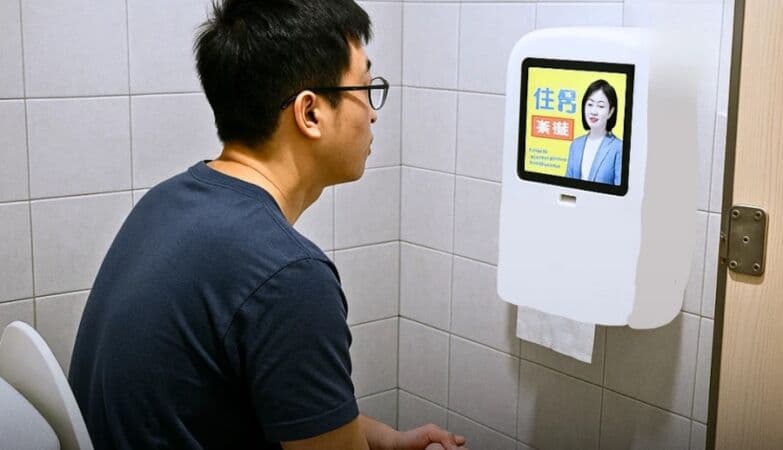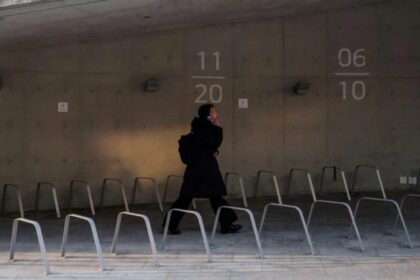A curious new rule in some China restrooms
Some public toilets in China are piloting a system that puts toilet paper behind a screen. To receive a small amount, visitors scan a QR code with a phone and watch a short advertisement. Those who do not want to view the ad can pay a small fee of 0.5 yuan, roughly seven US cents, to get paper immediately. City officials describe the trial as a way to cut waste and prevent people from taking large quantities from public facilities. The rollout has triggered a loud backlash online and a steady stream of videos showing confused or annoyed users trying the machines.
Local governments have not said how many units are installed or where the pilots will expand. It is also unclear what data the dispensers and their connected advertising platforms collect, and whether any personal information is anonymized. That gap in transparency sits at the heart of the debate, along with basic practical questions. What happens if a phone battery dies, mobile data is spotty, or someone does not use smartphone payment apps. Critics see a system that can leave people stuck in urgent situations or turn a simple public service into a captive audience for marketers.
The idea grew out of a long running problem at busy parks and transit hubs, where reports of theft and overuse have pushed managers to ration supplies. Many public bathrooms in China do not stock paper at all, a norm that leads residents to carry tissues. Facilities that do provide free rolls often become targets for people who take much more than they need. The new ad supported dispensers, and paid bypass options, are a modern attempt to get waste under control while helping cover costs. The tradeoff, according to many users, is convenience and dignity.
How the QR code dispensers work
The machines mount to restroom walls near sinks or stalls. A small screen or optical sensor presents a QR code. After a scan, the user’s phone connects to a service that starts a short promotional video. Reports and videos suggest the ads run for several seconds, in some cases around 30 seconds. When the clip ends, the device dispenses a fixed amount of toilet paper. To get more, users repeat the process or choose the paid option. The fee is modest, but the principle, and the timing, are what many object to.
Under the hood, each dispenser connects through a low power wireless module to an advertising platform that serves localized video spots. That design lets operators push different ads to different venues without sending a technician. A pre set dispensing length and a limit between requests help curb excessive use. In older rationing machines, the standard was one strip of about 60 centimeters and a cooldown period of nine to ten minutes before the same person could receive more. The new ad based units do not scan faces, and they may run shorter wait times, but details vary by model and city.
How much paper and how often
The precise allotment per ad view is not publicly standardized. Videos show a small handful, with the system designed to nudge people toward reasonable use. If someone needs more immediately, the pay option skips the ad and releases another measure. In theory, that balances conservation with flexibility. In practice, outcomes depend on how much paper a unit dispenses per cycle, the cooldown settings, and whether an attendant is present to handle exceptions.
Why officials say they are doing it
Municipal managers point to very old headaches. In high traffic parks, museums, and transit hubs, free supplies tend to disappear fast. Staff have reported visitors stuffing rolls into bags or pulling yards of paper for non restroom uses. Budget pressure adds to the problem. Restocking throughout the day is expensive, and waste ends up in trash bins that then need extra collection. Public campaigns that ask people to use less have not solved the issue by themselves.
Technology based rationing is a pragmatic tool from the administrator’s point of view. The machines cap individual use, deter casual theft, and, through advertising, create a revenue stream that helps cover the cost of paper and maintenance. For a city bureau charged with keeping bathrooms clean and stocked, the approach looks efficient on paper. Supporters also argue that the current pilots avoid face scans and rely on simple digital scans instead, which are easier to deploy and maintain.
Still, the optics are tricky. The bathroom is one of the most sensitive public spaces. Any system that inserts a commercial message between a person and a basic need will draw scrutiny. That is why the trials have turned into a broader conversation about how far monetization should go inside public infrastructure.
Backlash and bathroom dignity
Reactions from social media users inside and outside China have been scathing. Some call the set up dystopian. Others say the machines are a joke that will push people to carry their own supplies. The humor often covers up a serious point: a heavy reliance on phones and connectivity can exclude people at the exact moment they need quick help. That is the kind of friction users are more willing to forgive in a shopping mall than in a restroom.
One of the most shared criticisms came from a user on X who mocked the tradeoff as a loss of self respect in exchange for ad views. The line traveled widely because it captured the mood of the debate in a few sharp words.
In China even toilet paper forces you to watch ads. Dignity is no longer free, it is sponsored.
Many comments also raised practical worries. If the ad server stalls, a phone loses signal, or a tourist lacks local payment apps, a minor technology hitch becomes a major inconvenience. Those concerns do not disappear in pilot sites with attendants, since staff are not always at the door and lines move quickly only when the system works without hiccups.
Privacy, data, and the ad model
The shift from face recognition machines to QR code scans reduces one type of risk, but it introduces another: attention and data are now the currency. Scanning a QR code typically opens a link or mini program hosted by a platform. Even brief interactions can generate logs about time, device type, and location. Ad platforms often track how long a clip plays and whether a second request follows. Operators can claim that no personally identifiable information is kept, but the public does not have a clear view of how these logs are handled.
China’s Personal Information Protection Law places guardrails on data collection, purpose limitation, and consent. In practice, people scanning in a hurry may not read disclosures, and few can verify how the hardware, the venue, and the ad network coordinate back end storage. Transparency about retention periods, anonymization, and whether unique identifiers are involved would help build trust. Without that clarity, people naturally worry that a quick bathroom visit could leave a longer digital trace than they would expect.
There is also a business question. If advertising helps pay for paper, operators and ad partners have an incentive to maximize views. That can tilt system settings toward more frequent ad triggers or smaller allotments per view. A design that pairs conservation with convenience will look different from one that prioritizes impression counts. Public agencies will have to show that contract terms reward service quality, not just ad volume.
Accessibility and hygiene risks
Equity sits at the center of the criticism. Plenty of people either do not use smartphones, keep data off to save money, or run out of battery. Visitors with disabilities may find scanning awkward or slow. Children and older residents often rely on companions to handle digital tasks. A bathroom system that assumes a charged phone with internet access can fail these groups just when they need help the most.
Hygiene questions also come up. If the ad screen buffers or a QR code fails to load, delays can cause queues near the dispenser. Crowding at a single point of access is not ideal in a restroom. In past rationing pilots, managers sometimes told visitors to ask staff for extra paper in emergencies. Having an attendant nearby can solve edge cases, but only if staffing is consistent and the process is quick and discreet. Many travelers in China already carry tissues and hand sanitizer for this reason, since soap and paper are not guaranteed in older facilities.
This is not the first rationing experiment
China has tried to curb toilet paper theft before. In 2017, the Temple of Heaven park in Beijing installed dispensers that used a face scan to limit repeat use. The machines provided about 60 centimeters of paper per scan and blocked the same face from receiving more for nine minutes. By 2019, some locations stretched the wait to ten minutes. Park officials later said staff would hand out additional paper in urgent cases, a recognition that rigid settings do not fit every need.
The current pilots replace face scans with phone scans and insert an advertisement between the scan and the paper. Supporters say that is less intrusive, since there is no biometric capture. Critics reply that the new step still turns a basic need into a transaction and introduces new risks around data and fairness. The tension is a recurring theme in smart city projects: when technology tackles a problem of misuse, it can also create a new set of tradeoffs that need careful balancing.
How China’s approach compares abroad
Charging for restrooms is common in parts of Europe, where turnstiles or attendants collect a small entry fee. Those systems keep facilities funded and clean, but the transaction happens before entry and does not depend on a phone. In the United States, public bathrooms are usually free, with supplies paid through municipal budgets or business overhead. Vandalism and theft still occur, but operators tend to limit access by closing restrooms at night or requiring a code instead of rationing paper at the point of use.
Digital advertising has pushed into many public spaces, from gas pump screens to taxi displays. The difference in this case is the leverage created by urgency. Watching a commercial while filling a tank is optional, since a person can look away. Watching a clip to unlock paper during a restroom visit feels less optional, even if there is a paid escape. That is why the debate has been heated. People sense a line between helpful reminder and coercive design, and bathroom supplies sit very close to that line.
Key Points
- Some public restrooms in China are testing dispensers that require a QR code scan and a short ad before releasing a limited amount of toilet paper.
- Users can bypass the ad by paying 0.5 yuan, about seven US cents, to receive paper immediately.
- Officials frame the pilots as a way to reduce waste and deter theft in high traffic facilities.
- Authorities have not said how many machines are in use or how data from scans and ad views is handled.
- Public reaction has been largely negative, with many calling the setup dystopian and raising concerns about dignity and convenience.
- Critics highlight accessibility risks for people without smartphones, charged batteries, data service, or spare change.
- The approach follows a 2017 effort in Beijing that used face recognition dispensers to ration paper with nine to ten minute cooldowns.
- The new system replaces face scans with phone scans, but it ties access to advertising and raises privacy questions.
- Similar pay per use bathroom models exist in other countries, but they usually charge at the door rather than insert an ad before paper is dispensed.
- Whether these pilots expand will likely depend on user acceptance, data transparency, and contract terms that balance conservation with fair access.












